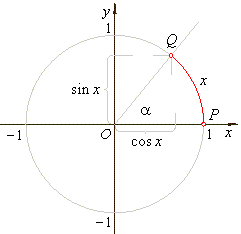|
The graph of
the
cosine function |
|
The graph of
the arc-sine function and the arc-cosine function |
|
|
|
|
|
|
|
·
Trigonometric
(cyclometric) functions and inverse trigonometric functions (arc
functions) |
|
Trigonometric functions are defined as the ratios of the sides of a right
triangle containing the angle equal to the argument of the
function in radians.
|
| Or
more generally for real arguments, trigonometric
functions are defined in terms of the coordinates of the
terminal point Q of
the arc
(or angle) of the unit circle with the initial point at P(1,
0). |
|
|
 |
 |
| sin2x
+ cos2x
= 1 |
|
|
|
| The
graphs of the trigonometric
functions and inverse trigonometric functions or arc-functions |
|
- The
sine function
y
= sin x
is the y-coordinate
of the terminal point of the arc x
of the unit circle. The
graph of the sine function is the sine curve or sinusoid. |
| In
a right-angled triangle the
sine function is equal to the ratio of the length of the side
opposite the given angle to the length of the hypotenuse. |
|
| The
graph of the
sine
function |
 |
 |
|
- The
cosine function
y
= cos x
is the x-coordinate
of the terminal point of the arc x
of the unit circle. The
graph of the cosine function is the cosine curve or cosinusoid. |
| In
a right-angled triangle the cosine function is equal to the
ratio of the length of the side adjacent the given angle to the
length of the hypotenuse. |
|
| The
graph of the
cosine
function |
 |
 |
|
|
- The
arc-sine function
y
= sin-1x
or y
= arcsin x
is the inverse of the sine function, so that its value for any
argument is an arc (angle) whose sine equals the given argument. |
| That
is, y
= sin-1x
if and only if x
= sin y.
For
example, |
 |
|
|
Thus, the arc-sine
function is defined for arguments between -1
and 1, and its principal
values are by
convention taken to be those between -p/2
and p/2. |
|
|
- The
arc-cosine function
y
= cos-1x
or y
= arccos x
is the inverse of the cosine function, so that its value for any
argument is an arc (angle) whose cosine equals the given
argument. |
| That
is, y
= cos-1x
if and only if x
= cos y.
For
example, |
 |
|
|
Thus, the arc-cosine
function is defined for arguments between -1
and 1, and its principal
values are by
convention taken to be those between 0 and p. |
|
| The
graph of the
arc-sine
function and the arc-cosine
function |
|
|
|
|
|
|
|
|